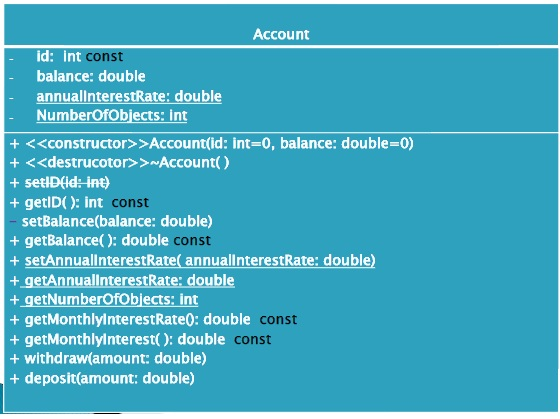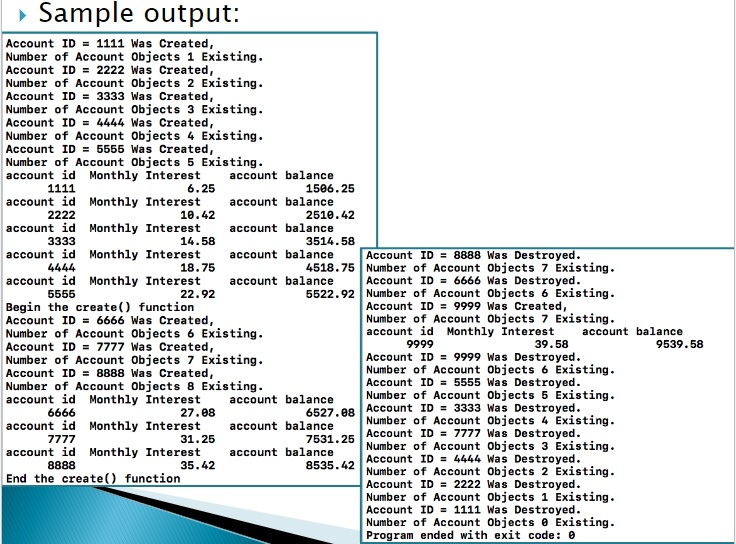Question
Account Class C++ Any help is greatly appreciated, thank you I am having trouble getting my code to print out correctly. As you can see
Account Class C++
Any help is greatly appreciated, thank you
I am having trouble getting my code to print out correctly. As you can see in the Sample output and my own output I can't get the numbers within "Number of Account object's 1" after the create() function and so on to match the correct output. I also can't get the numbers of the "account id","Monthly Interest" and "account balance" to show up either. I know the issue is within my Account.cpp file under the Constructor and the Destructor & within my AccountMain.cpp file int main() & create() function. I have tried multiple things and I keep getting errors or incorrect outputs. I have posted what I have done so far in my code below.
Write a test program that creates the following Account objects in order:
1.One global object before main with Account ID 1111, initial balance $1000 2.One static object before main with Account ID 2222, initial balance $2000 3.One local automatic object in main with Account ID 3333, initial balance $3000 4.One local static object in main with Account ID 4444, initial balance $4000 5.One local automatic object in main with Account ID 5555, initial balance $5000 6.One local automatic object in create() function with Account ID 6666, initial balance $6000 7.One local static object in create() function with Account ID 7777, initial balance $7000 8.One local automatic object in create() function with Account ID 8888, initial balance $8000 9.One local automatic object in main with Account ID 9999, initial balance $9000
Use the withdraw method to withdraw $500, use the deposit method to deposit $1000, and print the account ID, the monthly interest, and the balance for each account.
Hints for Header file and CPP file:
1.Set Account ID as a const variable, and use member initializer syntax to set the value. The default values of Account ID = 0 and initial balance =0. 2.Modify AnnualInterestRateas a static variable, the getAnnualInterestRate() and setAnnualInterestRate() methods as static, and set the initial value as 5%. 3.Add NumberOfObjectsvariable as static to keep tracking how many Account objects created. You need to make the necessary changes in the constructor and destructor functions, and add static getNumberOfObjects() function. 4.Make the setBalancefunction as a utility function (for internal use), change from the public access to the private access. 5.Use this pointer in the setBalancefunction, and the class name followed by the scope resolution operator (::) in the setAnnualInterestRatefunction. 6.Print out Account ID and NumberOfObjectsinfo whenever one Account object is created or destroyed. (Make the corresponding changes in the constructor and destructor functions.
UML Diagram:
 My Output :
My Output :

Here is my code so far:
Account.h
#ifndef Account_h
#define Account_h
class Account
{
const int id;
double balance;
double static annualInterestRate;
int static NumberOfObjects;
double setBalance(double ); // utility function
public:
Account(const int = 0, double = 0.0); // Constructor
~Account(); // Destructor
// set functions
void static setAnnualInterestRate(double); // set the initial value as 5% ??
// get functions
unsigned int getID() const;
double getBalance() const;
double static getAnnualInterestRate();
int static getNumberofObjects();
double getMonthlyInterestRate() const;
double getMonthlyInterest() const;
void withdraw(double);
void deposit(double);
};
#endif // Account_h
-------------------------------
Account.cpp ( need help checking if I did this correctly)
#include
#include
#include
#include "Account.h"
using namespace std;
double Account::annualInterestRate = 0.05;
int Account::NumberOfObjects = 1;
Account::Account(const int newID, double newBalance) // constructor initialises each data member
: id(newID), balance(newBalance)
{
const int id = newID;
balance = newBalance;
cout
cout
NumberOfObjects++;
}
Account::~Account() // destructor
{
cout
cout
NumberOfObjects--;
}
double Account::setBalance(double Newbalance)
{
this->balance = Newbalance;
return 0;
}
void Account::setAnnualInterestRate(double newannualInterestRate)
{
annualInterestRate = newannualInterestRate;
}
unsigned int Account::getID() const
{
return id;
}
double Account::getBalance() const
{
return balance;
}
double Account::getAnnualInterestRate()
{
return annualInterestRate;
}
int Account::getNumberofObjects()
{
return NumberOfObjects;
}
double Account::getMonthlyInterestRate() const
{
return (annualInterestRate / 12);
}
double Account::getMonthlyInterest() const
{
return balance*(annualInterestRate / 12);
}
void Account::withdraw(double withdrawAmount)
{
if (balance >= withdrawAmount)
{
balance -= withdrawAmount; //balance = balance - withdrawAmount
}
else
throw invalid_argument("No sufficient balance");
}
void Account::deposit(double depositAmount)
{
balance += depositAmount; //balance = balance + depositAmount
}
-------------------------------
AccountMain.cpp (Where I am unsure what im doing is correct)
#include
#include
#include
#include "Account.h"
using namespace std;
Account account1 (1111, 1000);
static Account account2 (2222, 2000);
int main()
{
Account account3 (3333, 3000);
static Account account4 (4444, 4000);
Account account5 (5555, 5000);
cout
cout
cout
void create();
{
cout
Account account6 (6666, 6000);
static Account account7 (7777, 7000);
Account account8 (8888, 8000);
cout
cout
cout
cout
cout
}
Account account9 (9999, 9000);
cout
cout
cout
return 0;
}
Account id: int const balance: double annuallnterestRate: double NumberOfObjects: int + >Account(id: int=0, balance: double-0) + >Account) + setlDd: int) + getID( : int const setBalance(balance: double) + getBalance(): double const + setAnnuallnterestRate( annuallnterestRate: double) + getAnnuallnterestRate: double + getNumberfObjects: int + getMonthlylnterestRate0 + getMonthlylnterest(): double + withdraw(amount: double) + deposit(amount: double) : double const const
Step by Step Solution
There are 3 Steps involved in it
Step: 1

Get Instant Access to Expert-Tailored Solutions
See step-by-step solutions with expert insights and AI powered tools for academic success
Step: 2

Step: 3

Ace Your Homework with AI
Get the answers you need in no time with our AI-driven, step-by-step assistance
Get Started


